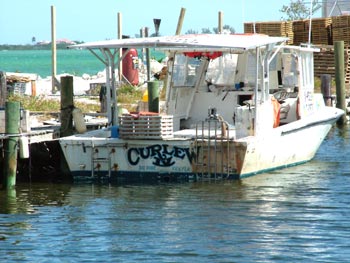Lobstering In Margaritaville
by Jeff Della Penna
|
About 2,000 miles separate the mid-coast of Maine from the Florida Keys. The distance between these two extreme eastern corners of the United States seems even farther, if that’s possible, in the middle of a long cold winter. When our sky is as cold, gray and menacing as our seas, just the mention of Key West can conjure up all sorts of images of white sand beaches, coconut palms and tropical waters the color of a robin’s egg. Is there really a place where sternmen wear swimsuits under their oilers, where the water feels like a warm bath on Sunday and where the sweet/sour stink of pickled bait is a thing of the past?
Florida does have a lobster fishery, six million pounds landed, worth $20 million. Those numbers pale a little in comparison to the yield in Maine, where 10 times that amount were landed. But, if you’re tired of freezing your butt off with 7,400 other Maine lobstermen, then maybe competing against only 800 licensed Florida bug hunters is for you. But before you burn your LL Bean woolies and load your lobster yacht onto a borrowed trailer, be forewarned, the Florida fishery may sound like lobster heaven to some of us, but it has all of the same problems as the New England fishery and a few that some might suggest loom in Maine’s immediate future.
Buddy Becker, 53, has been lobster and crab fishing, out of Big Pine, Florida’s CFSD (Commercial Fishing Special District), for the last 30 years. Becker works 2,000 lobster (AKA crawfish) traps and 3,000 stone crab traps. He says his total trap number puts him in the upper 70 percent of fishery average. He also runs a buying company called “D & D,” with his four sons.
|

A typical lobster boat at Big Pine, Florida near Key West. The metal rack over the stern is where the wood trap is placed, flipped up, lobster removed and rebaited. Most fishermen use a stern puller. Photo Fishermen's Voice. |
Becker was driving home from Miami, when we talked, in mid-February. It was 7:30 at night and he had the air conditioner in his car turned on and the window cracked. “It’s about 70, 75 degrees here,” Becker said, with a chuckle. “What’s it like up there in Maine?”
Becker came down from Michigan 34 years ago. His story is pretty common. Just about everyone you meet in the Keys has moved here from someplace cold.
continue
|
|
|
Down Easters
Belaying Pin Soup at the Roaring Forties.
by Mike Crowe
|
The Panic of 1857 marked the beginning of the worst depression in the U.S. up to that time and held that dark record until 1929. This “panic” or economic crash, ruined thousands of businesses, created massive unemployment of industrial workers and slammed shut the era of the clipper ship. The civil war was, in part, precipitated by the desperation the panic brought on for both the north and south. Maine, geographically remote from Antietam, Richmond, and Gettysburg, was, in fact the front line at sea in that war.
With the most ships, builders, owners, investors and sailors, Maine felt, more than other states, the impact of the south’s lesser-known victories at sea. Confederate cruisers like the Alabama, were taking clipper ships, fishing boats, coastal schooners and square riggers in numbers that left the New England coastal industry devastated by the end of the war.
continue
|
 Cape Horners were seamen’s seamen. Crewmen worked in the rigging in all kinds of weather at all hours of the day year round. In the southern ocean sudden storms could explode sails out of the rigging or require crewmen to climb 175 feet up and out onto the ends of yards to shorten sail. Cape Horners were seamen’s seamen. Crewmen worked in the rigging in all kinds of weather at all hours of the day year round. In the southern ocean sudden storms could explode sails out of the rigging or require crewmen to climb 175 feet up and out onto the ends of yards to shorten sail. |
|
|
  
|
|

